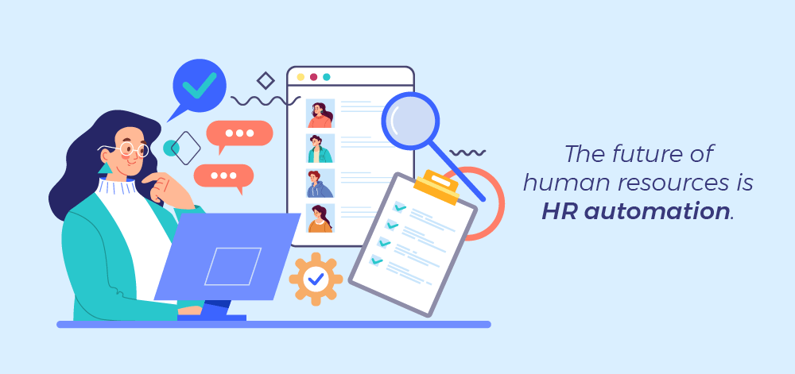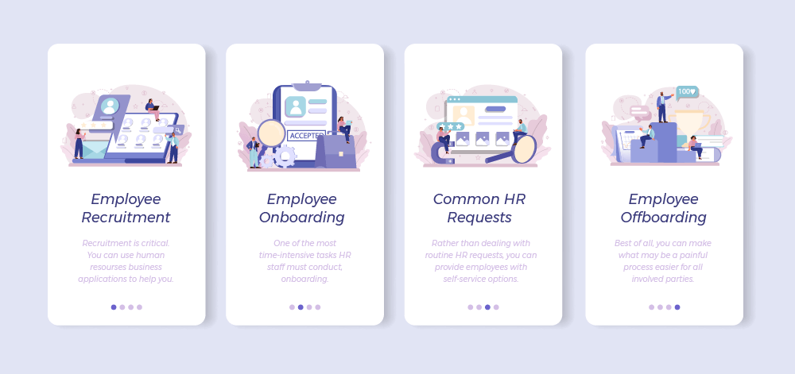Stop us if you've heard this one before: the future of human resources is HR automation. Yes, but the systems you've seen, or even tried to integrate, are too difficult to use or tailor to your unique business.

Right now, you're continuing to handle most, if not all, of your HR operations manually, leaving your trained and experienced HR staff to perform an extraordinary amount of busywork. They're pushing paperwork rather than keeping your employees' skills current through training, handling complex and potentially costly compliance issues, and developing internal pipelines for rising stars to become company leaders.
A recent study conducted by Recruiter found that HR departments lose a full 8-hour day due to manual tasks. That means your HR department is spending just four days a week:
- Recruiting effectively
- Assessing the performance of your employees
- Managing the relationship between labor and management
- Providing training and professional development
- Planning for succession
- Handling compliance issues
- Managing employee workplace safety and health
Another study by CareerBuilder put the number higher, at 14 hours a week — nearly two full days! Your HR staff can't perform these critical strategic functions on a part-time schedule, which is why you must reduce as many manual HR tasks as possible — as soon as possible.

HR Functions You Can and Should Automate
What would you rather do: wrestle with technology or empower your team? The HR tools can automate some of your most common and time-consuming tasks, including:
- Recruitment
- Employee Onboarding
- Common HR requests
- Employee Offboarding
When you automate these functions, you free your HR staff up to add real value to your organization. You can also perform these tasks more efficiently and uniformly, saving you time, and ultimately, money.
Recruitment
Recruitment is critical. And while, ultimately, selecting the right candidate must and should be done by people, automation minimizes the administrative burden of doing so. You can use HR business applications to help you:
- Collect, sort, and rank job applications
- Schedule and keep track of interviews
- Collaborate with other managers involved in the hiring process
- Communicate with applicants throughout the process
- Send offer letters and rejection letters as appropriate
You can standardize your hiring process, which will save you time and help you remain in compliance with hiring laws and regulations. You can also easily keep track of promising candidates for future opportunities as well.
Employee Onboarding
One of the most time-intensive tasks HR staff must conduct, onboarding, involves:
- Scheduling orientation meetings as well as meetings with relevant department heads
- Collecting and verifying documents
- Providing equipment and access to online tools
- Enrolling members into employee benefits programs
- Organizing and providing initial training
But these tasks can be automated in whole or in part, saving you time, providing your new hire a better employee experience, and making cross-departmental communication more efficient.
Common HR requests
Which of these questions do your staff ask you most frequently?
- Which days are considered holidays?
- Can you provide me an employment verification letter?
- What's my leave balance?
- Can I view my personnel file?
- Why am I being taxed so much, and what deductions did I list?
- Can you send me a duplicate tax form?
- What is the HR policy concerning this particular issue?
- Can you send me a copy of my last performance appraisal?
No matter how innocuous these questions seem, answering them often takes time. And even when you can answer these questions relatively quickly, the sheer volume of them coming from all corners of your organization impedes your ability to get more strategic tasks accomplished.
Rather than dealing with routine HR requests, you can provide employees with self-service options that allow them to access the information they seek.
Employee Offboarding
When an employee leaves, it's common for emotions to run high. And when emotions run high, mistakes are often made. You can mitigate the risk of making mistakes by automating standard employee offboarding functions, such as:
- Communicate the change to all affected employees
- Coordinate training between the exiting employee and their replacement
- Recover devices and other company assets
- Coordinate benefits enrollment changes
- Revoke credential access
- Schedule exit interviews
- Ensure necessary paperwork, such as non-disclosure or non-compete agreements, are signed, as necessary
- Handle miscellaneous tasks, such as updating org charts, removing items the former employee may have left behind, and updating your records
Best of all, you can make what may be a painful process easier for all involved parties.
How Automating Common Functions of HR Improves HR
It's also not uncommon to wonder whether automating HR functions will reduce HR staff. However, the intent of doing so is to empower HR staff to perform the full range of their duties. Think about whether you would rather have an HR specialist with a background in employee training and conflict resolution, spending their time doing those things, or making copies of W-2s for your staff.
When your staff members are crushed by paperwork and tedious administrative tasks, they can't complete these value-added tasks thoroughly, and in some cases, at all. This not only hurts the morale and productivity of your HR employees themselves but can leave your organization at a strategic disadvantage.
No longer are you assured of recruiting the best and brightest or knowing which current employees are over-performing and who is underperforming. Unattended compliance issues could cost you large sums, while lingering labor-management issues could grind your productivity to a halt. And overperforming employees unable to take advantage of training and professional development opportunities may decide there is no future for them at your company and leave.
HR is supposed to help you lead and empower your team. Yet too often, they lack the time to do so. When you free up that time, you give them the resource they need to help you manage processes and people. More importantly, you provide them with the opportunity and flexibility to work directly with staff, ensure they are engaged and motivated, pinpoint and resolve burgeoning conflicts, and identify opportunities for employee growth.
By utilizing low-code development tools to automate your most routine HR functions, you can ensure your HR department provides the strategic support and direction your organization needs. There's no better time to get started than now. Contact us at eSystems and learn how we can help you automate your most time-consuming HR functions today.

WRITTEN BY: Mika Roivainen | Chief Digitalization Officer




COMMENTS